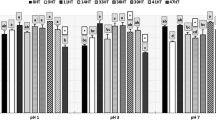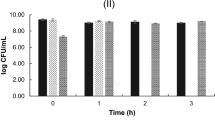Abstract
In this study, seven bacteriocinogenic and non-bacteriocinogenic LAB strains previously isolated from the intestines of Nile tilapia and common carp and that showed potent antibacterial activity against host-derived and non-host-derived fish pathogens were assayed for their probiotic and safety properties so as to select promising candidates for in vivo application as probiotic in aquaculture. All the strains were investigated for acid and bile tolerances, transit tolerance in simulated gastrointestinal conditions, for cell surface characteristics including hydrophobicity, co-aggregation and auto-aggregation, and for bile salt hydrolase activity. Moreover, haemolytic, gelatinase and biogenic amine-producing abilities were investigated for safety assessment. The strains were found to be tolerant at low pH (two strains at pH 2.0 and all the strains at pH 3.0). All of them could also survive in the presence of bile salts (0.3% oxgall) and in simulated gastric and intestinal juices conditions. Besides, three of them were found to harbour the gtf gene involved in pH and bile salt survival. The strains also showed remarkable cell surface characteristics, and 57.14% exhibited the ability to deconjugate bile salts. When assayed for their safety properties, the strains prove to be free from haemolytic activity, gelatinase activity and they could neither produce biogenic amines nor harbour the hdc gene. They did not also show antibiotic resistance, thus confirming to be safe for application as probiotics. Among them, Lactobacillus brevis 1BT and Lactobacillus plantarum 1KMT exhibited the best probiotic potentials, making them the most promising candidates.

Similar content being viewed by others
References
FAO (Food and Agriculture Organization of the United Nations) (2016) The state of world fisheries and aquaculture—contributing to food security and nutrition for all. FAO fisheries and aquaculture technical paper, Rome, p 204
Sahoo TK, Jena PK, Nagar N, Patel AK, Seshadri S (2015) In Vitro evaluation of probiotic properties of lactic acid bacteria from the gut of Labeo rohita and Catla catla. Probiotics Antimicrob Proteins. doi:10.1007/s12602-015-9184-8
Tekwombuo J (2013) Hatchery design and brood stock management policy as a tool for sustainable aquaculture: case of Cameroon. United Nations University Fisheries Training Programme, Iceland http://www.unuftp.is/static/fellows/dociment/joseph13prf.pdf
Kaktcham PM, Zambou NF, Fonteh AF, Pérez-Chabela ML (2015) Aquaculture in Cameroon and potential of lactic acid bacteria to be used as diseases controlling agents. A review. Nacameh 9(1):1–18
Kaktcham PM, Temgoua J-B, Zambou NF, Diaz-Ruiz G, Wacher C, Perez-Chabela ML (2017) Quantitative analyses of the bacterial microbiota of rearing environment, tilapia and common carp cultured in earthen ponds and inhibitory activity of its lactic acid bacteria on fish spoilage and pathogenic bacteria. World J Microbiol Biotechnol 33(2):1–12
Martínez Cruz P, Ibáñez AL, Monroy Hermosillo OA, Ramírez Saad HC (2012) Use of probiotics in Aquaculture. Int Sch Res Netw 2012:916845 13p
Giri SS, Sukumaran V, Sen SS, Vinumonia J, Nazeema B, Jena PK (2011) Antagonistic activity of cellular components of probiotic bacteria, isolated from the gut of Labeo rohita, against Aeromonas hydrophila. Probiotics Antimicrob Proteins 3:214–222
Sala BG (2013) Isolation, identification and antimicrobial activity of bacteriocinogenic lactic acid bacteria from marine origin: biochemical and genetic characterisation and heterologous production of curvacins G14 and G15 from Lactobacillus curvatus BCS35. Ph.D thesis, University Complutense of Madrid, pp 177–224
Verschuere L, Rombaut G, Sorgeloos P, Verstraete W (2000) Probiotic bacteria as biological control agents in aquaculture. Microbiol Mol Biol Rev 64:655–671
Austin B, Austin DA (2007) Bacterial fish pathogens: diseases of farmed and wild fish, 4th edn. Springer-Praxis, Chichester
Gatesoupe FJ (2008) Updating the importance of lactic acid bacteria in fish farming: natural occurrence and probiotic treatments. J Mol Microbiol Biotechnol 14:107–114
Giri SS, Sukumaran V, Dangi NK (2012) Characteristics of bacterial isolates from the gut of freshwater fish, Labeo rohita that may be useful as potential probiotic bacteria. Probiotics Antimicrob Proteins 4:238–242
Muñoz-Atienza E, Gómez-Sala B, Araújo C, Campanero C, del Campo R, Hernández PE, Herranz C, Cintas LM (2013) Antimicrobial activity, antibiotic susceptibility and virulence factors of lactic acid bacteria of aquatic origin intended for use as probiotics in aquaculture. BMC Microbiol 13:15
Balcázar JL, Blas I, Ruiz-Zarzuela I, Cunningham D, Vendrell D, Muzquiz JL (2006) The role of probiotics in aquaculture. Vet Microbiol 114:173–186
Kumar R, Mukherjee SC, Paniprasad K, Pal AK (2006) Evaluation of Bacillus subtilis as a probiotic to Indian major carp Labeo rohita (ham.) Aquacult Res 37:1215–1221
Son VM, Chang CC, Wu MC, Guu YK, Chiu CH, Cheng W (2009) Dietary administration of the probiotic, Lactobacillus plantarum, enhanced the growth, innate immune responses, and disease resistance of the grouper Epinephelus coioides. Fish Shellfish Immunol 26:691–698
Verdenelli MC, Ghelfi F, Silvi S, Orpianesi C, Cecchini C, Cresci A (2009) Probiotic properties of Lactobacillus rhamnosus and Lactobacillus paracasei isolated from human faeces. Eur J Nutr. doi:10.1007/s00394-009-0021-2
Stack HM, Kearney N, Stanton C, Fitzgerald GF, Ross RP (2010) Association of betaglucan endogenous production with increased stress tolerance of intestinal lactobacilli. Appl Environ Microbiol 76:500–507
Vrancken G, Rimaux T, Weckx S, De Vuyst L, Leroy F (2009) Environmental pH determines citrulline and ornithine release through the arginine deiminase pathway in Lactobacillus fermentum IMDO 130101. Int J Food Microbiol 135:216–222
Corcoran BM, Stanton C, Fitzgerald GF, Ross RP (2005) Survival of probiotic lactobacilli in acidic environments is enhanced in the presence of metabolizable sugars. Appl Environ Microbiol 71(6):3060–3067
Dashkevicz MP, Feighner SD (1989) Development of a differential medium for bile salt hydrolase-active Lactobacillus spp. Appl Environ Microbiol 55:11–16
Ekmekci H, Aslim B, Ozturk S (2009) Characterization of vaginal lactobacilli coaggregation ability with Escherichia coli. Microbiol Immunol 53:59–65
ISO 10932/IDF 223 (2010) Milk and milk products—determination of minimal inhibitory concentration (MIC) of antibiotics applicable to bifidobacteria and non-enterococcal lactic acid bacteria (LAB)
EFSA (2012) Guidance on the assessment of bacterial susceptibility to antimicrobials of human and veterinary importance. EFSA J 10(6):2740
Danielsen M, Wind AA (2003) Susceptibility of Lactobacillus ssp. to antimicrobial agents. Int J Food Microbiol 82:1–11
CLSI (Clinical and Laboratory Standards Institute) (2009) Methods for dilution antimicrobial susceptibility tests for bacteria that grow aerobically; Approved standard-Eight Edition. CLSI document M07-A8 (ISBN 1–56238–689-1). Clinical and Laboratory Standards Institute, 940 West Valley Road, suite 1400, Wayne, Pennsylvania 19087–1898 USA
Gerhardt P, Murray RG, Costilow RN, Nester EW, Wood WA, Krieg NR, Phillips GB (1981) Manual of methos for general bacteriology. American Soc Microbiol. Washington, DC 20006
Harrigan WF, Mc Cance ME (1990) Laboratory methods. In: Harigan WF, Mc Cance ME (eds) Food and dairy microbiology. Academic press, New York, pp 12–15
Bover-Cid S, Holzapfel WH (1999) Improved screening procedure of biogenic amine production by lactic acid bacteria. Int J Food Microbiol 53:33–41
Costantini A, Cersosimo M, Del Prete V, Garcia-Moruno E (2006) Production of biogenic amines by lactic acid bacteria: screening by PCR thin-layer chromatography, and high-performance liquid chromatography of strains isolated from wine and must. J Food Prot 69:391–396
Buntin N, Chanthachum S, Hongpattarakere T (2008) Screening of lactic acid bacteria from gastrointestinal tracts of marine fish for their potential use as probiotics. Songklanakarin J Sci Technol 30(Suppl.1):141–148
Balcázar JL, Vendrell D, Blas ID, Ruiz-Zarzuela I, Muzquiz JL, Girones O (2008) Characterization of probiotic properties of lactic acid bacteria isolated from intestinal microbiota of fish. Aquaculture 278:188–191
Chemlal-Kherraz D, Sahnouni F, Matallah-Boutiba A, Boutiba Z (2012) The probiotic potential of lactobacilli isolated from Nile tilapia (Oreochromis niloticus)’s intestine. Afr J Biotechnol 11(68):13220–13227
Turpin W, Humblot C, Guyot JP (2011) Genetic screening of functional properties of lactic acid bacteria in a fermented pearl millet slurry and in the metagenome of fermented starchy foods. Appl Environ Microbiol 77(24):8722–8734
Vizoso Pinto MG, Franz CMAP, Schillinger U, Holzapfel WH (2006) Lactobacillus spp. with in vitro probiotic properties from human faeces and traditional fermented products. Int J Food Microbiol 109:205–214
Argyri AA, Zoumpopoulou G, Karatzas K-AG, Tsakalidou E, Nychas G-JE, Panagou EZ, Tassou CC (2013) Selection of potential probiotic lactic acid bacteria from fermented olives by in vitro tests. Food Microbiol 33:282–291
Solieri L, Bianchi A, Mottolese G, Lemmetti F, Giudici P (2014) Tailoring the probiotic potential of non-starter Lactobacillus strains from ripened Parmigiano Reggiano cheese by in vitro screening and principal component analysis. Food Microbiol 38:240–249
González-Vázquez R, Azaola-Espinosa A, Mayorga-Reyes L, Reyes-Nava LA, Shah NP, Rivera-Espinoza Y (2015) Isolation, identification and partial characterization of a Lactobacillus casei strain with bile salt hydrolase activity from pulque. Probiotics Antimicrob Proteins 7(4):242–248
Todorov SD, Holzapfel W, Nero LA (2016) In Vitro evaluation of beneficial properties of bacteriocinogenic Lactobacillus plantarum ST8Sh. Probiotics Antimicrob Proteins 9:194–203
Kos B, Suskovic J, Vukovic S, Simpraga M, Frece J, Matosic S (2003) Adhesion and aggregation ability of probiotic strain Lactobacillus acidophilus M92. J Appl Microbiol 94:981–987
Kaktcham PM, Zambou NF, Tchouanguep MF, El-Soda M, Iqbal Choudhary M (2012) Antimicrobial and safety properties of Lactobacillus strains isolated from two Cameroonian traditional fermented foods. Sci Pharm 80(1):189–203
Elkins CA, Mullis LB (2004) Bile-mediated aminoglycoside sensibility in Lactobacillus species likely results from increased membrane permeability attributable to cholic acid. Appl Environ Microbiol 70:7200–7209
Herreros MA, Fresno JM, Sandoval H, Gonzáles L, Castro JM, Tornadijo ME (2004) Antimicrobial activity and antibiotic resistance of lactic acid bacteria isolated from Armada cheese (a Spanish goats’ milk cheese). Food Microbiol 22:455–459
Rojo-Bezares B, Sáenz Y, Poeta P, Zarazaga M, Ruiz-Larrea F, Torres C (2006) Assessment of antibiotic susceptibility within lactic acid bacteria strains isolated from wine. Int J Food Microbiol 111:234–240
Kumar A, Kumar D (2014) Isolation and characterization of bacteria from dairy samples of Solan in Himachal Pradesh for identification of Lactobacillus spp. Int J Pharm Sci Rev Res 25:110–114
Charteris WP, Kelly PM, Morelli L, Collins JK (2001) Gradient diffusion antibiotic susceptibility testing of potentially probiotic lactobacilli. J Food Prot 64:2007–2014
Katla AK, Kruse H, Johnsen G, Herikstad H (2001) Antimicrobial susceptibility of starter culture bacteria used in Norwegian dairy products. Int J Food Microbiol 67:147–152
Acknowledgements
The authors are grateful to TWAS (The World Academy of Sciences for the development of science in developing countries) and CONACyT (Consejo Nacional de Ciencia y Tecnología, México) for their support through TWAS-CONACyT postdoctoral fellowship (FR number: 3240275624) awarded to K.P.M.
Author information
Authors and Affiliations
Corresponding author
Ethics declarations
Conflict of Interest
The authors declare that they have no conflict of interest.
Research Involving Human Participants and/or Animals
Not applicable.
Informed Consent
Not applicable.
Rights and permissions
About this article
Cite this article
Kaktcham, P.M., Temgoua, JB., Zambou, F.N. et al. In Vitro Evaluation of the Probiotic and Safety Properties of Bacteriocinogenic and Non-Bacteriocinogenic Lactic Acid Bacteria from the Intestines of Nile Tilapia and Common Carp for Their Use as Probiotics in Aquaculture. Probiotics & Antimicro. Prot. 10, 98–109 (2018). https://doi.org/10.1007/s12602-017-9312-8
Published:
Issue Date:
DOI: https://doi.org/10.1007/s12602-017-9312-8




